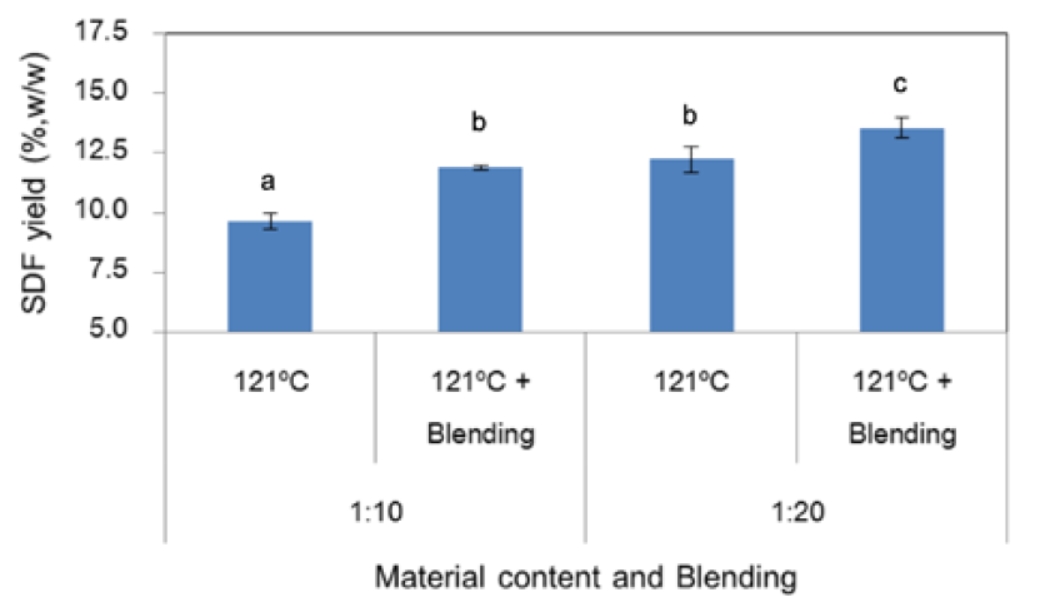The effect of material pretreatment, substrate content, enzyme concentration and extraction time on yield of soluble dietary fiber from asparagus by-product
DOI:
https://doi.org/10.60136/bas.v13.2024.1243Keywords:
Soluble dietary fibers, Asparagus by-products, Enzymatic dietary fiber extractionAbstract
This research aims to study the effect of material pretreatment (temperature and wet blending), substrate content, enzyme concentration (cellulase and hemicellulase) and extraction time on yield of soluble dietary fibers (SDF) from asparagus by-products. This study found that material pretreatment (temperature and wet blending), substrate content, enzyme concentration (cellulase and hemicellulase) and extraction time effected on SDF yield from asparagus by-products significantly (p < 0.05). The extraction condition from this study were material pretreatment of 1:20 (asparagus: water) at 121 °C, 15 lb./sq. inch for 15 min, wet blending to slurry, hydrolysis by using 2.5% (v/w) of cellulase and 2.5% (v/w) of hemecellulase at pH 4.6, 50 °C for 4 h. These condition gave 11.26 ± 0.63% (w/w) of SDF yield. The obtained SDF consisted of 69.06 ± 0.40% (w/w) of total dietary fiber (TDF) which classified to 67.97 ± 0.92% (w/w) of SDF and 1.09 ± 0.53% (w/w) of insoluble dietary fiber (IDF). The obtained SDF had 1.40 ± 0.07 g/g of water holding capacity, 1.64 ± 0.42 g/g of oil holding capacity and 75.45 ± 0.25% (w/w) of water solubility index. Moreover, the obtained SDF had antioxidant activity (IC50 2.31 mg/mL). These results indicated that these conditions had effect on the potential of SDF extraction from asparagus by-products.
References
Chitrakar B, Zhang M, Adhikari B. Asparagus (Asparagus officinalis): Processing effect on nutritional and phytochemical composition of spear and hard-stem byproducts. Trends Food Sci Technol. 2019;93:1-11.
Pegiou E, Mumm R, Acharya P, de Vos RCH, Hall RD. Green and white asparagus (Asparagus officinalis): A source of developmental, chemical and urinary intrigue. Metabolites. 2019;10(17):1-23.
Fuentes-Alventosa JM, Rodriguez-Gutirrez G, Jaramillo-Carmona S, Espejo-Calvo JA, Rodriguez-Arcos R, Fernandez-Bolanos J, Guillin-Bejarano R, Jiminez-Araujo A. Effect of extraction method on chemical composition and functional characteristics of high dietary fibre powders obtained from asparagus by- products. Food Chem. 2009;113(2):665-71.
Dhingra D, Michael M, Rajput H, Patil RT. Dietary fibre in foods: a review. J Food Sci Technol. 2012;49(3):255-66.
กมลลักษณ์ วิชาเร็ว. ผลของวิธีการสกัดต่อสมบัติทางเคมีกายภาพและสมบัติเชิงหน้าที่ของเส้นใยอาหารจากหน่อไม้ เศษเหลือ. (วิทยานิพนธ์หลักสูตรปริญญาวิทยาศาสตรมหาบัณฑิต), พะเยา: มหาวิทยาลัยพะเยา; 2563
Hu H, Zhao Q. Optimization extraction and functional properties of soluble dietary fiber from pineapple pomace obtained by shear homogenization-assisted extraction. RSC Adv. 2018;8(72):41117-30.
Chen H, He S, Sun H, Li Q, Gao K, Miao X, Xiang J, Wu X, Gao L, Zhang Y. A comparative study on extraction and physicochemical properties of soluble dietary fiber from glutinous rice bran using different methods. Separations. 2023;10(2):1-13.
Ma C, Ni L, Guo Z, Zeng H, Wu M, Zhang M, Zheng B. Principle and application of steam explosion technology in modification of food fiber. Foods. 2022;11(3370):1-19.
Prosky L, Nils-Georg ASP, Schweizer TF, Devries JW, Furda I. Determination of insoluble, soluble and total dietary fiber in foods and food products: Interlaboratory study. J Assoc Off Anal Chem. 1988;71(5):1017-24.
Cadavid ELA, Molina DAR, Valenzuela JRC. Chemical, physicochemical and functional characteristics of dietary fiber obtained from asparagus byproducts (Asparagus officinalis L.). Rev Fac Nal Agr Medellín. 2015;68(1):7533-44.
Chen GT, Zhao L, Zhao LY, Cong T, Bao SF. In vitro study on antioxidant activities of peanut protein hydrolysate. J Sci Food Agric. 2007;87(2):357-62.
Qi B, Jiang L, Li Y, Chen S, Sui X. Extract dietary fiber from the soy pods by chemistry enzymatic methods. Procedia Eng. 2011;15:4862-73.
Cheng L, Zhang X, Hong Y, Li Z, Li C, Gu Z. Characterisation of physicochemical and functional properties of soluble dietary fibre from potato pulp obtained by enzyme-assisted extraction. Int J Biol Macromol. 2017;101:1004-11.

Downloads
Published
How to Cite
Issue
Section
License
Copyright (c) 2024 Bulletin of Applied Sciences

This work is licensed under a Creative Commons Attribution-NonCommercial-NoDerivatives 4.0 International License.









